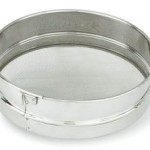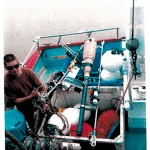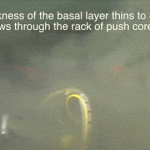![]() Oil and gas extraction is pervasive among the coasts of the world. In many areas, such as the Gulf of Mexico and off the coast of west Africa, resource exploration companies have been moving into pretty deep waters. Many rigs use water-based muds in the drilling process. It is considered to the best alternative because effects on the benthic community have been detected no further than 100 meters from a source (as to 500 and 1000 meters for synthetic and oil based muds, respectively). Drill mud is important as it keeps water pressure down, brings up drill cuttings and prevents the oil or gas from bursting up the pipes and causing damage to the rig or the workers.
Oil and gas extraction is pervasive among the coasts of the world. In many areas, such as the Gulf of Mexico and off the coast of west Africa, resource exploration companies have been moving into pretty deep waters. Many rigs use water-based muds in the drilling process. It is considered to the best alternative because effects on the benthic community have been detected no further than 100 meters from a source (as to 500 and 1000 meters for synthetic and oil based muds, respectively). Drill mud is important as it keeps water pressure down, brings up drill cuttings and prevents the oil or gas from bursting up the pipes and causing damage to the rig or the workers.
Near oil and gas rigs, sedimentation can be very high since many of the drill cuttings stay behind, as does some of the mud. Because many animals living on the seafloor have little to no mobility, sedimentation can prove to be a major hazard. Clams and mussels can get their siphons clogged, corals and anemones must expend much energy to clear particles and worms and crustaceans living in the sediment can get buried and their oxygen depleted if the rate of sedimentation is greater than the rate that animals can mix the sediment up (bioturbation). Additionally, many deposit and suspension feeders are very selective about their sediment grain size. The new sediment composition reflects the grain size of the drill cuttings and not the overlying sediments, potentially causing difficulties in feeding for these animals.
Trannum and colleagues used a mesocosm set-up to compare the effects of sedimentation by water-based drill cuttings and natural sedimentation (i.e. sediment form the seafloor). They tested different thicknesses of overlying sediment, up to 24 mm. The take home message was that in nearly every instance the water-based drill cuttings had a much stronger effect on the community compared to a control tank (containing no particles) than did natural sedimentation. Some of the effects were lower biomass, lower abundance, and lower species richness and diversity. Additionally, when group species by their higher-level taxon or feeding strategy Trannum and colleagues observed lower abundance in each group. These experiments clearly show that water-based drill cuttings depress the sediment community whereas natural sediment has no effect.
One argument used by drilling companies is that the ocean is large and therefore anything that is done to the ocean is diluted. But observations from Norwegian rigs show that drill cutting can accumulate to 10 mm as much 250 meters away, potentially impacting an area over 196,000 m2 surrounding an individual rig.
What this study shows is that it is not the act of sedimentation that is detrimental to a sediment community, because natural sedimentation had no effect, but instead an intrinsic property of the water-based drill cuttings. They also measured oxygen penetration in the sediment and found that only the water-based drill cuttings decreased the depth of detectable oxygen in the sediment. One hypothesis is that water-based drill muds contain the common additive glycol, a lubricant and stabilizing agent, which may be the smoking gun. Hence, the “safer” alternative to drill fluids might not be so safe after all. This is not to say that it isn’t the safest alternative compared to oil-based and synthetic drill muds, but engineers and researchers will need to look more carefully at the properties of water-based drill muds to see why it is still harmful to the sediment communities.
—————————————————————————————–
Trannum, H., Nilsson, H., Schaanning, M., & Øxnevad, S. (2010). Effects of sedimentation from water-based drill cuttings and natural sediment on benthic macrofaunal community structure and ecosystem processes Journal of Experimental Marine Biology and Ecology, 383 (2), 111-121 DOI: 10.1016/j.jembe.2009.12.004






2 Replies to “‘Safe’ Water-Based Drill Cuttings Affect Seafloor Animals”
Comments are closed.